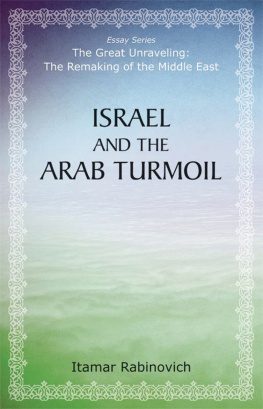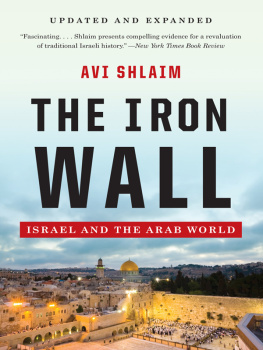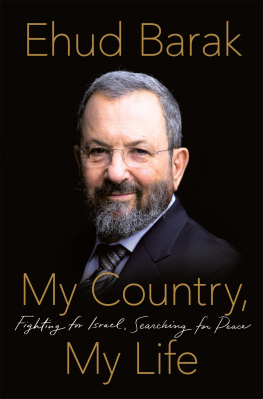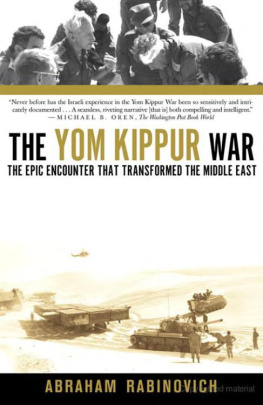THE
LINGERING
CONFLICT
ISRAEL, THE ARABS,
AND THE MIDDLE EAST
19482011
ITAMAR RABINOVICH
A SABAN CENTER AT THE
BROOKINGS INSTITUTION BOOK
BROOKINGS INSTITUTION PRESS
Washington, D.C.
Copyright 2011
THE BROOKINGS INSTITUTION
1775 Massachusetts Avenue, N.W., Washington, DC 20036
www.brookings.edu
All rights reserved. NO part of this publication may be reproduced or transmitted in any form or by any means without permission in writing from the Brookings Institution Press.
Library of Congress Cataloging-in-Publication data
Rabinovich, Itamar, 1942-
The lingering conflict : Israel, the Arabs, and the Middle East, 1948-2011 / Itamar Rabinovich.
p. cm.
Includes bibliographical references and index.
Summary: A detailed history and analysis of Arab-Israeli relations and
the conflict between two peoples claiming the same land, exploring through
firsthand experience how these relations have been shaped over the years and
assessing the prospects for a peaceful futureProvided by publisher.
ISBN 978-0-8157-2228-1 (cloth : alk. paper)
1. Arab-Israeli conflict1993- I. Title.
DS119.76.R329 2011
946.08dc23 2011041176
9 8 7 6 5 4 3 2 1
Printed on acid-free paper
Typeset in Sabon
Composition by Cynthia Stock
Silver Spring, Maryland
Printed by R. R. Donnelley
Harrisonburg, Virginia
In memory of my mother
TOVA BUCHSBAUM RABINOVICH
T his book is based on my book Waging Peace, first published by Farrar, Straus in 2000 and then in 2004 by Princeton University Press in a revised and updated paperback version. Several colleagues who have assigned the book in their classes and other interested individuals have urged me in the past few years to update it once again given the massive changes that have occurred in Arab-Israeli relations since 2003. When I finally decided to undertake the task, it soon transpired that more than just an update was required.
This volume includes two and a half new chapters that cover Ariel Sharon's last two years in power, Ehud Olmert's tenure, and Barack Obama's and Benjamin Netanyahu's record in Middle Eastern diplomacy thus far. In addition, I have updated and revised other chapters where necessary. The Lingering Conflict differs from the editions of Waging Peace in two main respects. Waging Peace was a study of Arab-Israeli relations since 1948, but its core was the peace process of the 1990s. This is not the case with The Lingering Conflict. Also, as the change of title and subtitle implies, the new book reflects a harsher realitya decline of the peace process, a festering of the conflict, and a broadening of the arena with two Muslim, non-Arab regional actors, Iran and Turkey, assuming more prominent roles in Middle Eastern politics and Arab-Israeli affairs.
Of the book's nine chapters, seven are written as a narrative and the final two are analytical. I chose this structure so that I could let the narrative flow without too many digressions and yet be able to elaborate on substantive issues in the analytical chapters. This choice entails a bit of repetition, but it seems to me on balance that the book and the readers end up benefiting.
It is a pleasant duty to thank several individuals and institutions for their help and support. I am grateful to Haim Saban and Charles Bronfman for sponsoring my fellowship at the Saban Center and for their friendship over many years. Strobe Talbott, Martin Indyk, Ken Pollack, Dan Byman, and many others at Brookings and the Saban center have offered friendship and professional support. It was a genuine pleasure to collaborate with Bob Faherty, the director of the Brookings Institution Press, and with the editorial team: Janet Walker, Martha Gottron, and John Felton. I am grateful to the management of Princeton University Press and to my former editor, hanne Winarsky, for facilitating the transition from Waging Peace to The Lingering Conflict. At tel Aviv University, several colleagues at the Dayan Center and the Institute of National Security Studies have been generous with their time and expertise. I am grateful to DOV Weissglas, Yoram Turbowicz, and Shalom Tourheman for valuable insights. Special thanks go to my associate Dr. Tamar Yegnes and to my assistants Moran Azoulay and Nitsan Dori.
Tel Aviv
October 2011
T he Arab-Israeli conflict is now in its seventh decade. An earlier conflict between the small Jewish and the much larger Arab community in Palestine had first erupted in the late Ottoman period. It became fiercer and more significant after the First World War, the publication in 1917 of the Balfour Declaration (in which the British government supported the establishment in Palestine of a national home for the Jewish people), and the establishment in 1920 of a British Mandate over Palestine on both sides of the Jordan River. During the next three decades, Arabs and Jews fought over rights and control, their conflict culminating in a war that broke out after the United Nations' decision in 1947 to partition Palestine between a Jewish state and a Palestinian-Arab one.
Throughout the decades of low-level conflict, the indigenous Palestinian Arabs were supported and helped by a large part of the Arab world, but the conflict widened following the establishment of the state of Israel in 1948 and the immediate invasion by five Arab armies. Israel's victory, the consolidation of its existence and expansion of its original territory, the Arabs' military defeat, the failure to establish the Palestinian Arab state envisaged by the UN resolution, and the consequent problem of Palestinian refugees were the fundamental facts in the process that transformed the Arab-Jewish conflict in Mandate Palestine into the ArabIsraeli conflict we still know today.
The conflict's history is divided by the October War of 1973. For twenty-five years after the creation of Israel, the old wounds festered as efforts to heal them or at least address some of their causes failed for reasons that I analyze. But after the Israeli victory in October 1973, diplomatic procedures were inaugurated that developed into an Israeli-Egyptian peace process, which in March 1979 produced Israel's first peace treaty with an Arab state. This process subsequently came to a grinding halt, and the ensuing stasis lasted through the 1980s. Then a new phase of peace negotiations was inaugurated in October 1991 at the Madrid Conference. These negotiations gave birth to a second Israeli peace treaty in 1994, with Jordan, to a Palestinian-Israeli breakthrough, and to a significant degree of Arab-Israeli normalization. Even in the heyday of the Madrid process in 1993-95, this phase failed to bring about a comprehensive settlement of the Arab-Israeli conflict or to end the political disputes and the bloodshed between Israel and parts of the Arab world. New developments in 1996 slowed negotiations and in 1998 brought them near collapse.
The Madrid process represents the first sustained international effort to resolve the Arab-Israeli conflict. It is significant that no comparable effortas distinct from short-lived attempts, various mediation efforts, and partial settlementshad been undertaken before, and that nearly forty years of an uneven peace process have still failed to produce a comprehensive settlement. The Arab-Israeli conflict has indeed been one of the most complex and difficult international problems of the second half of the twentieth century and into the current century. The first step to understanding its complexity is to recognize that there is no single Arab-Israeli dispute but a cluster of distinct, interrelated conflicts:






